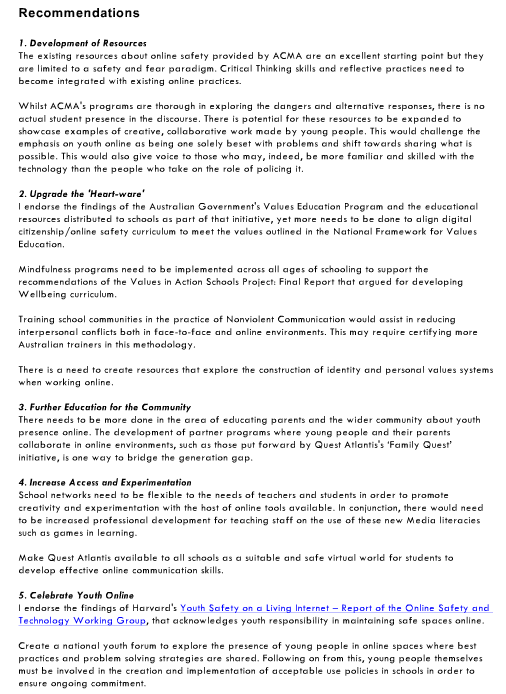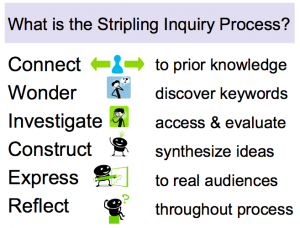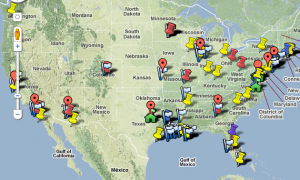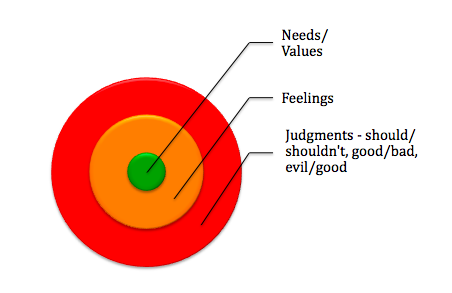‘The teenager seems to have replaced the Communist as the appropriate target for public controversy and foreboding.’
~Edgar Friedenberg, The Vanishing Adolescent
 Wherever I have travelled in the US, one name has frequently been cited with regard to online safety and global citizenship- Anne Collier. A journalist by profession, Anne is a ‘Truth- teller’ who’s work through NetFamilyNews.org and ConnectSafely.org, is cited by those who seek a more reasoned, less sensational voice in this highly charged domain.
Wherever I have travelled in the US, one name has frequently been cited with regard to online safety and global citizenship- Anne Collier. A journalist by profession, Anne is a ‘Truth- teller’ who’s work through NetFamilyNews.org and ConnectSafely.org, is cited by those who seek a more reasoned, less sensational voice in this highly charged domain.
Anne served on the Internet Safety Technical Task Force, formed by 49 state attorneys general at Harvard’s Berkman Center for Internet & Society as well as participating in various advisory boards, attending international conferences, and co-chairing the Obama Administration’s Online Safety and Technology Working Group , which sent its report to the US Congress last June.
It was a delight to meet with Anne and encounter a voice that actively challenges perceptions that parents and schools have about the safety of young people online.
This posting will blend Anne’s understanding of this issue with my own musings on the subjects of fear, youth voice and the label ‘digital natives’.
The origins of Fear
It is perhaps unsurprising that the majority of schools in America adopt a fear-based, protective attitude towards young people’s use of the internet given the origins of legislation pertaining to it.
Anne recounted the origins of Federal legislation dating back to the 1990s when the internet was still in its Web 1.0 infancy. Whilst initially the National Center for Missing and Exploited Children made use of the internet to find displaced kids, this set the scene for framing children and young people as potential victims: not an auspicious start. From the get-go, young people online was perceived as something risky.
Having interactions of young people with the internet already associated with Law enforcement and the Department of Justice predisposed the response taken by those bodies. Thus police began giving presentations to parents that demonstrated, in real-time, the predatory nature of some chat rooms by entering the spaces as a fictional student. These experiences served to alarm parents. To this day such presentations emphasizing the potential risks, threats and legal ramifications are still being delivered to students, staff and parents. In such instances the most egregious acts against children are revealed, skewing the public perception further.
Fear was later enshrined in legislation. The amusing, if aggressively titled, Deleting Online Predators Act (DOPA) was meant to cause schools to block or seriously restrict access to social networking websites rather than “predators,” actually. This bill was not based on sound evidence linking instances of child molestation and/or grooming behaviours to social networks. Not the least controversial aspect of the bill was the emotive and misleading title. Worryingly, if one spoke in opposition of the bill one was perceived to be somehow in support of predators.
Thankfully the bill did not pass. But children still seem to be seen by policymakers only as potential victims and passive consumers online rather than agents of their own and others’ well-being in online community.
Next up: The Protecting Children in the 21st Century Act. The parameters of this Act were to inhibit the creation and distribution of child pornography, to protect young people from online predators once more and to remove the possibility of commercial exploitation of youth. Once again, young people were framed as passive, innocent, defenseless victims.
(3) with the explosive growth of trendy chat rooms and social networking websites, it is becoming more and more difficult to monitor and protect minors from those with devious intentions, particularly when children are away from parental supervision. Section 202 12-16
Anne was a consultant on the formation of this bill and watched as it was passed from the Senate to the Commerce, Science, and Transportation Committee for further discussion. Thus, the Senate believed that the care and safety of young people, now perceived as some form of commodity, also belonged to the Department of Commerce rather than solely to the Department of Justice. This lead to conflict between the two departments with the boycotting of reports and a vying for control over who actually ‘owned’ online safety.
If we add to this confusion over jurisdiction the prevailing culture of fear maintained by the Bush Administration’s War on Terror, it is perhaps unsurprising that little was actually achieved in the arena of online safety and digital citizenship for over eight years.
The limitations of Fear
Clearly, the mainstream perception was and still is that fear is a useful tool; the understanding being that, if you scare parents and children then you will ‘scare them straight’ into becoming model citizens. Well, as we all know, that censorious approach has always been an effective deterrent against young people experimenting with drugs, engaging in underage drinking and promiscuity.
Fear does the exact opposite of what we actually need which is to generate a culture of reasoned discussion and debate. What fear does is scare parents and administrators into closing down access based on fear of what might happen. (In an increasingly litigious culture, fear is seen as a guardian against possibly crippling legal payouts. My observation, not Anne’s.)
Fear-based reactions remove the very resources young people’s need to help them make informed decisions. Safe, loving and informed adults are removed from the equation, replacing them with frightened reactionaries who shut off avenues for discussion. Thus, young people are left to go underground and rely on their peers to negotiate the complexities of online cultures, putting them at greater risk. As Quentin Crisp, a renowned victim of perceived fear put it, ‘The young always have the same problem – how to rebel and conform at the same time. They have now solved this by defying their parents and copying one another.’
The discrediting of Fear
The fear-dominated discourse is being challenged as the findings of comprehensive studies question many of the assumptions held by parents and school administrators. Anne mentioned two significant reports published in recent years with which she was involved that have attempted to dispel misconceptions.
At the request of the Multi-State Working Group on Social Networking, comprising of 49 state Attorneys General, the Enhancing Safety and Online Technologies Report (2008) was commissioned. Written by the Internet Safety Technical Task force, comprising of leaders from social network sites (including Facebook), academics, technology developers, teachers, internet service providers and consumer advocacy organizations, the report was published by the Berkman Center for Internet and Society at Harvard University.
The Task force accomplished a comprehensive literature review and examined data from numerous rigorous studies. The report deals a serious blow to the rhetoric of fear and to the framing of young people as innocent victims of adult manipulation.
“The Literature Review shows that the risks minors face online are complex and multifaceted and are in most cases not significantly different than those they face offline, and that as they get older, minors themselves contribute to some of the problems.” page 4
The report goes on to explore some significant points.
• More studies need to be done around the area of sexual predation of minors by adults and of minors by minors (this latter area is understudied and “not part of most conversations about online safety”)
• Bullying and harassment are most common forms of negative interaction both online and offline.
• The internet increases the availability of questionable material such as pornography but does not automatically increase exposure.
• Young people are not equally at risk online – “The psychosocial makeup of and family dynamics surrounding particular minors are better predictors of risk than the use of specific media or technologies.”
• Young people themselves can contribute to the construction of unsafe environments.
The report makes three key recommendations, none of which involved banning access or censorship, rather they advocate greater exposure and evaluation of online tools.
1.All stakeholders in online communities need to share responsibility for protecting young people online.
2.More training in risk assessment and online safety practices needs to be developed for all who work with young people.
3.Parents and caregivers need to educate themselves about the internet and evaluate the use of tools in their own family context.
What is radical about this report is that it acknowledges the role young people themselves play in creating risky online cultures. For the first time young people are acknowledged as active agents in this arena. Also, the wording of point three is particularly relevant. Parents and caregivers are not asked to be educated but rather ‘educate themselves’ thus framing them also as active agents in dispelling misconceptions.
The second report, published in June 2010, Youth Safety on a Living Internet – report of the online safety and technology working group, from the Online Safety & Technology Working Group, evaluated existing online safety practices/resources promoted by the telecommunications industry and the education sector. Anne was the Co-chair of this working group made up of child-safety advocates, government officials, representatives from various internet and telecommunications industries, educators, and civil liberties groups.
One of the key understandings raised in this report is that-
“…thanks to the growing body of youth-online-risk research, we are now able to seek solutions as a society which are fact-based, not fear-based, but also that minors themselves – mainly pre-teens and teens (though the tech-literacy age is going down) – have a role to play in improving their own safety online and that of their peers.”
The sub-committee on Internet Safety Education also made some powerful recommendations as part of the report.
• “nationwide education in digital citizenship and media literacy as the cornerstone of Internet safety.”
• Avoid scare tactics and promote the social-norms approach to risk prevention.
• Promote instruction in digital media literacy and computer security in pre-K-12 education nationwide.
• Create a Digital Literacy Corps for schools and communities nationwide.
• Encourage full, safe use of digital media in schools’ regular instruction and professional development in their use as a high priority for educators nationwide
• Respect young people’s expertise and get them involved in risk-prevention education. (my emphasis)
As comprehensive, informative and myth-busting as these reports were, they were controversial and received considerable criticism. Even the review of peer-reviewed research in the ISTTF report was attacked. Attempts were made to discredit the findings. It appears views which challenge the status quo are themselves challenged.
The most significant aspect of both these reports, aside from taking a less reactionary approach and presenting a reasoned response to the issues, is that young people themselves are considered part of the problem itself and also part of the solution. Young people were now seen as stakeholders in their own right who were not only to be protected but also respected.
The alternative to Fear – Respect for Youth
Young people today are not just adults in training.
The Macarthur Foundation recently invested fifty million dollars and three years to do both quantitative and qualitative ethnographic research on youth culture in the Digital Youth Project. The extensive research acknowledged a new sociology of youth. The book Hanging Out, Messing Around and Geeking Out – kids living and Learning with New Media drew on the findings of the Digital Youth Project and makes it abundantly clear that there is a lot we need to do to earn the respect of young people.
They have their own cultures and societal norms in online spaces. As such there is an imperative to respect what they have to offer and to hear their voices on matters that concern them in a meaningful, consequential way. We can’t unreservedly impose our expectations upon young people any longer.
Sadly, Anne believes that in all her travels, talking to students, presenting to parents and administrators, attending conferences, consulting and chairing working groups she is yet to find a forum that is deeply respectful of youth. There are organizations that do enlist student voice – Inspire USA, Reachout.org, Childnet International, Common Sense Media, and Global Kids being some groups that actively seek out young people’s opinions on matters that concern them but none that respect the wisdom, experiences and inquiries of youth in ways that give them leadership in the field of online safety/digital citizenship.
Like the young audiences such adults are attempting to reach, Anne is bored by a rhetoric that seeks to inform rather than consult. I added that young people want and need to learn just not to be taught while it happens. Developmentally, adolescents are moving away from investing in adult figures of authority or at the very least questioning the decisions made by them. Ironically, this is the very time that adults frequently offer more feedback and make greater demands. Informed, authoritative voices of ‘cybersafety experts’ make it clear what has to be done to young people, for young people but not alongside young people.
When it comes to the ubiquitous ‘cybersafety’ lectures made by law enforcement or so-called online safety experts, Anne says that they may as well be carpenters given the way they are brought in to ‘fix’ a problem. This attitude is fundamentally disrespectful to young people. It says that we are the wise ones and your experience does not matter, in fact, you are broken in some capacity. Is it any wonder that they stop listening to us and go underground? In the words of the newspaper columnist Judith Martin, “Chaperones don’t enforce morality; they force immorality to be discreet.”
One significant way we can listen to and respect the positive choices made by the vast majority of young people is to take a different slant on data. In five New Jersey schools that were recently studied, Anne noted the findings of researchers from Hobart and William Smith in New York State that when there was a notable decrease in the perception of the frequency and instances of bullying, the number of actual instances of bullying went down. Why? The schools made concerted efforts to celebrate the positive data: the high percentages of students who were maintaining societal norms rather than over emphasizing those who transgressed.
It is to the voice of social imperative that young people turn. This social urgency is a necessity in young people – it is what starts them on pushing boundaries and refining the ability to assess risks effectively. Both of these are essential in developing independence.
Where is the opportunity to allow young people to meet their social needs and provide a forum/community of inquiry around safety and global citizenship? Instead we have teachers, politicians, journalists and businesses applying their value sets, their societal norms to young people without consultation. There is a need for us to step back and for the young to step up.
Learning to respect our elders.
We may be chronologically older, but in terms of experience in online spaces, young people are our elders.
The term ‘digital natives’ is one usually applied to describe the generation brought up alongside the internet. I personally dislike the term ‘digital native’. It is reminiscent of another meaning of the word ‘native’ that was once associated with patriarchal colonialism. Young people are not ‘natives’ who need to be saved from danger through re-education and tempted to conform by the offer of shiny beads in the forms of access, privileges and liberties.
Some time ago I coined the term ‘Simmigrant’ – a conflation of Simulated and Immigrant – to describe the experience of we now stand in relation to the online world. The internet is a new territory for us to discover and inhabit. First Generation Simmigrants – children and young people – came to this ‘country’ earlier, sometimes by themselves with a more courageous, pioneering attitude. Why did they leave their ‘homeland’ of traditional community and education? Perhaps they left for the adventure of exploring new ground? Perhaps they wanted to go where they felt kinship? Perhaps they wanted to find out what it felt like to be creatively free or perhaps, just perhaps we in the ‘old country’ failed to inspire them anymore. Perhaps if we actually asked them we might discover the truth and find out what more they need?
To do that we also need to travel, to become Second Generation Simmigrants or risk widening the divide between our two worlds
We won’t travel from the ‘old country’ without both unnecessary and essential baggage. In our suitcases we bring the ability to think critically, to reflect, to question and also a larger historical perspective that they could not easily carry. Our elders also don’t travel light either- in their luggage is stowed innovation, creativity, enthusiasm, innocence, experience, wit and a great deal of skill.
Anne believes that we are at a pivotal time in history when we have the opportunity to help free the wisdom in young people, to help unpack their suitcases and fully belong. To do that we must empower young people to connect to themselves more deeply, to learn to respect themselves and others in a way that builds upon the communities they are constructing. We need to provide our elders with opportunities to document their digital lives so that we may learn just who they are and what they have achieved. For this to occur we must give access to the very tools they enable this history to be recorded otherwise they will do it all on their own without the benefits collaborating with us would bring.
In order to begin our journey, we must give up fear-based reactions and promote a culture of mutual respect.










Recent Comments